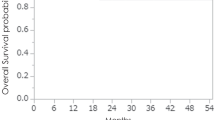Abstract
Background
Clinical results of computed tomography (CT) simulations and [18F]-fluoro-2-deoxyglucose (FDG) positron emission tomography (PET)/CT simulations were compared retrospectively.
Materials and methods
Between 2006 and 2011, [18F]-FDG PET/CT simulation was performed on 68 consecutive patients with pharyngeal cancers (PET/CT group). As an historical control, conventional CT simulation was performed on 56 consecutive patients with pharyngeal cancer between 2000 and 2006 (CT group). In the PET/CT group, the primary sites were nasopharynx (NPC), oropharynx (OPC), and hypopharynx (HPC) in 35, 20, and 13 patients, respectively; in the CT group, the primary sites were NPC, OPC, and HPC in 21, 17, and 18 patients, respectively. All but five patients in the PET/CT group were treated with intensity modulated radiation therapy (IMRT).
Results
In the PET/CT group, TNM and clinical stages changed in 11 (16 %) and eight (12 %) patients, respectively. Although the 5-year overall survival (OS) rates for the PET/CT and the CT groups were 80 and 64 %, respectively (p = 0.0420), this result may be attributable to the background difference between the two groups. Similarly, the 5-year locoregional control rates of the two groups were 82 and 70 %, respectively (p = 0.0501). Notably, marginal recurrences around the planning target volume (PTV) were only noted in four CT group patients.
Conclusion
PET/CT simulation was useful for delineating an accurate clinical target volume (CTV) of pharyngeal cancer, and its clinical results were satisfactory.



Similar content being viewed by others
References
Schoenfeld GO, Amdur RJ, Morris CG et al (2008) Patterns of failure and toxicity after intensity-modulated radiotherapy for head and neck cancer. Int J Radiat Oncol Biol Phys 71:377–385
Eisbruch A, Marsh LH, Dawson LA et al (2004) Recurrences near base of skull after IMRT for head-and-neck cancer: implications for target delineation in high neck and for parotid gland sparing. Int J Radiat Oncol Biol Phys 59:28–42
Chao KS, Ozyigit G, Tran BN et al (2003) Patterns of failure in patients receiving definitive and postoperative IMRT for head-and-neck cancer. Int J Radiat Oncol Biol Phys 55:312–321
Raktoe SA, Dehnad H, Raaijmakers CP et al (2013) Origin of Tumor recurrence after intensity modulated radiation therapy for oropharyngeal squamous cell carcinoma. Int J Radiat Oncol Biol Phys 85:136–141
Nishimura Y, Shibata T, Nakamatsu K et al (2010) A two-step intensity-modulated radiation therapy method for nasopharyngeal cancer: the Kinki University experience. Jpn J Clin Oncol 40:130–138
Rohde M, Dyrvig AK, Johansen J et al (2014) 18F-fluoro-deoxy-glucose-positron emission tomography/computed tomography in diagnosis of head and neck squamous cell carcinoma: a systematic review and meta-analysis. Eur J Cancer 50:2271–2279
Xu G, Li J, Zuo X et al (2012) Comparison of whole body positron emission tomography (PET)/PET-computed tomography and conventional anatomic imaging for detecting distant malignancies in patients with head and neck cancer: a meta-analysis. Laryngoscope 122:1974–1978
Deantonio L, Beldì D, Gambaro G et al (2008) FDG-PET/CT imaging for staging and radiotherapy treatment planning of head and neck carcinoma. Radiat Oncol 3:18–29
Kao CH, Hsieh TC, Yu CY et al (2010) 18F-FDG PET/CT-based gross tumor volume definition for radiotherapy in head and neck cancer: a correlation study between suitable uptake value threshold and tumor parameters. Radiat Oncol 5:2–76
Wang D, Schultz CJ, Jursinic PA et al (2006) Initial experience of FDG-PET/CT guided IMRT of head-and-neck carcinoma. Int J Radiat Oncol Biol Phys 65:143–151
Schwartz DL, Ford EC, Rajendran J et al (2005) FDG-PET/CT-guided intensity modulated head and neck radiotherapy: a pilot investigation. Head Neck 27:478–487
Vernon MR, Maheshwari M, Schultz CJ et al (2008) Clinical outcomes of patterns receiving integrated PET/CT-guided radiotherapy for head and neck carcinoma. Int J Radiat Oncol Biol Phys 70:678–684
Eisbruch A, Foote RL, O’Sullivan B et al (2002) Intensity-modulated radiation therapy for head and neck cancer: emphasis on the selection and delineation of the targets. Semin Radiat Oncol 12:238–249
Okubo M, Nishimura Y, Nakamatsu K et al (2010) Radiation treatment planning using positron emission and computed tomography for lung and pharyngeal cancer: a multiple-threshold method for [18F] fluoro-2-deoxyglucose activity. Int J Radiat Oncol Biol Phys 77:350–356
Okubo M, Nishimura Y, Nakamatsu K et al (2008) Static and moving phantom studies for radiation treatment planning in a positron emission tomography and computed tomography (PET/CT) system. Ann Nucl Med 22:579–586
Tang L, Li L, Mao Y et al (2008) Retropharyngeal lymph node metastasis in nasopharyngeal carcinoma detected by magnetic resonance imaging. Cancer 113:347–354
Zheng XK, Chen LH, Wang QS et al (2007) Influence of FDG-PET on computed tomography-based radiotherapy planning for locally recurrent nasopharyngeal carcinoma. Int J Radiat Oncol Biol Phys 69:1381–1388
Hickeson M, Yun M, Matthies A et al (2002) Use of a corrected standardized uptake value based on the lesion size on CT permits accurate characterization of lung nodules on FDG-PET. Eur J Nucl Med Mol Imaging 29:1639–1647
Paulino AC, Johnstone PA (2004) FDG-PET in radiotherapy treatment planning: pandora’s box? Int J Radiat Oncol Biol Phys 59:4–5
Fukui MB, Blodgett TM, Snyderman CH et al (2005) Combined PET-CT in the head and neck: part 2. Diagnostic uses and pitfalls of oncologic imaging. Radiographics 25:913–930
Vorwerk H, Hess CF (2011) Guidelines for delineation of lymphatic clinical target volumes for high conformal radiotherapy: head and neck region. Radiat Oncol 6:19–97
Suzuki M, Nishimura Y, Nakamatsu K et al (2006) Analysis of interfractional set-up errors and intrafractional organ motions during IMRT for head and neck tumors to define an appropriate planning target volume (PTV)- and planning organs at risk volume (PRV)-margins. Radiother Oncol 78:283–290
Acknowledgments
This study was partially supported by a Grant-in-Aid for Scientific Research (25461932, 16K10406) from Japan Society for the Promotion of Science, and by the Practical Research for Innovative Cancer Control from Japan Agency for Medical Research and Development, AMED (15ck0106093h0002).
Author information
Authors and Affiliations
Corresponding author
Ethics declarations
Conflict of interest
None.
About this article
Cite this article
Matsuura, T., Nishimura, Y., Nakamatsu, K. et al. Clinical outcomes of IMRT planned with or without PET/CT simulation for patients with pharyngeal cancers. Int J Clin Oncol 22, 52–58 (2017). https://doi.org/10.1007/s10147-016-1034-5
Received:
Accepted:
Published:
Issue Date:
DOI: https://doi.org/10.1007/s10147-016-1034-5




